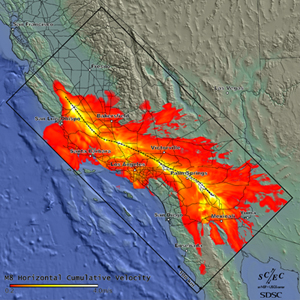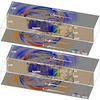Home
The High Performance GeoComputing Lab (HPGeoC) at San Diego Supercomputer Center, University of California at San Diego, is conducting research and development in high performance computing, data intensive computing, and grid computing to support geoscience applications, with particular emphasis on computational seismology. HPGeoC is in collaboration with Southern California Earthquake Center (SCEC) and other academic, industrial, and national lab partners to develop state-of-the-art techniques and applications supporting petascale earthquake computing.
Most Recent News
* SDSC and Intel open second Intel Parallel Computing Center at SDSC - Intel has opened a second parallel computing center at SDSC with a focus on earthquake research. SDSC, February 9, 2016.
- Fault Finding: SoCal Researchers Use GPUs to Detect Earthquake Hazards Coming Our Way - SCEC recently completed CyberShake 15.4 calculation for 336 separate locations in the Los Angeles region involving a large ensemble of earthquakes, and doubled the maximum simulated frequency from 0.5 Hertz to 1 Hertz, therefore also doubled accuracy. As that measurement increases, so does the potential for damage-and the complexity of the simulation. Structures such as buildings and bridges are most vulnerable to damage by seismic waves between 1 and 10 hertz. NVIDIA Blog, Aug 31, 2015.
- SDSC Researchers Awarded NVIDIA 2015 Global Impact Award - NVIDIA's Global Impact Award is an annual award of $150,000 to researchers who use NVIDIA technology, such as Titan's GPUs, for groundbreaking work that addresses social, humanitarian, and environmental problems. NVIDIA presented Cui and his team at SDSC with the award at the GPU Technology Conference March 17-20 in San Jose, HPCWire, April 9, 2015.
- Research Shows a Way Forward in Making Earthquake Scenarios More Accurate - SDSC computational scientist Dr. Roten performed ShakeOut simulations with San Andreas fault zone plasticity on Kraken at the National Institute for Computational Sciences (NICS). His study suggest that the nonlinear behavior in rocks could reduce the previous simulation-based estimates of expected ground motion velocity in the Los Angeles basin during a magnitude-7.8 event on the southern San Andreas Fault by 30 to 70 percent. NICS News, May 13, 2014.
|




